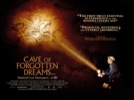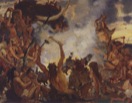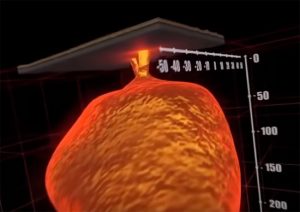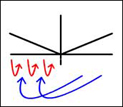A Summary of the History of the World, in Videos
THE STONE AGE
by Edward Ulrich, updated February 20, 2022
The videos on this page detail a time period from the rise of pre-human hominids to about eight thousand years ago. It is a part of the article “A Summary of the History of the World, in Videos.”

This well-made movie recreates the reality of Neanderthals first coming into contact with modern Humans. It portrays a period in time when Neanderthals supposedly knew how to use fire that they already found in nature, but they didn’t yet know how to make it themselves. [Editor’s note updated February 20, 2022: This movie seems very plausible, except perhaps for a segment near its beginning where the Neanderthals were attacked by a tribe of an apparently earlier hominid species that actually no longer existed at that time. Also Neanderthals actually always knew how to use fire since such knowledge long predates even them. In any event I’m impressed by how the filmmakers were able to create a very compelling narrative with the subject matter. Please note that this is an “R” rated movie and it contains a few sex scenes that are rather graphic. (Apparently the idea of the filmmakers was to depict the primal nature of their existence that way, I think an edit of the movie with most of such scenes cut out would be good).]

This 2010 French language film is a depiction of the time when Neanderthals were first coming into contact with modern humans. [Note updated February 17, 2022: This is a well-made movie, but I don’t think humans would have looked so much like modern Europeans at that time, for example the main female character appears to have shaven legs. Also note there are a few sex scenes in the movie.]

This documentary explains the discovery of 180 thousand year old Neanderthal fire pits inside the Bruniquel Cave in France.

This video explains that many modern humans have traces of Neanderthal DNA, as well as DNA from recently discovered “Denisovans”; with native populations in Australia having particularly high amounts of Denisovan DNA.

This documentary explains aspects of Neanderthal physiology that made them well-adapted for cold northern climates, evidence of Neanderthals meeting in large groups on an annual basis, evidence of Neanderthal abstract expression, evidence of Neanderthals meeting modern humans starting at about 50,000 years ago, and it explains how Neanderthals became extinct about 40,000 years ago.
[Note: I think the most important discovery in human history is when hominids learned how to make fire. I wouldn’t want to live during any era other than the current one, but I think it would have been particularly miserable to live in a time before people knew how to use fire. It would have been fascinating to witness that discovery happening. I wonder how many times hominids accidentally created fire before they learned how to do it in a controlled manner, it can be rather easy to create sparks by striking two rocks together.]




This video shows how a fire can be made quickly using simple materials from nature, as is demonstrated in New Guinea.

This video demonstrates how to make a fire simply by striking two rocks together. It is explained that it only works with certain types of rocks that have a high iron pyrite content.

This video shows how to make a fire using only sticks found in nature and a string. [Note: As this video shows, starting a fire using the “spindle-drill” method is rather specific, where it is useful for an additional notch to exist at the point of contact with the stick in order for it to gather a smoldering lump of dust that is created by the friction. Previously I was under the impression that it was simply heat from the friction that directly caused the combustion, not realizing that such a notch is useful to accumulate a burning coal. I’ve seen it done without using a string and bow as well, but I’m sure the bow makes the process much easier.]
In 2013, cave explorers in South Africa discovered a narrow chamber in a cave that contained skeletal remains, which prompted an investigation that showed them to belong to an ancient hominin species. Once that was determined, a large expedition was sent into the cave, where skeletons of more than 15 individuals of a new “Homo Naledi” species were recovered. It is by far the largest find of ancient hominin skeletons, and it shows that they were likely intelligent enough to dispose of their dead in the cave in an apparently ritualistic manner, despite the fact that their brains were not much larger than a chimpanzee’s.



This video explains the discovery of over 15 “Homo Naledi” hominids in the Rising Star Cave in South Africa, who likely lived 335,000 years ago.

This in-depth documentary explains the discovery and recovery of the “Homo Naledi” fossils from the Rising Star Cave in South Africa. From the video page: “An unprecedented wealth of fossils belonging to a crucial gap in the record of our origins that spans the transition between the ape-like australopithecines and early members of the human family have been found in a South African cave.”
These videos from the PBS “Eons” series summarize information about the origins of humanity.












This video explains an interesting quirk of genetics where “mitochondrial DNA” is passed only from mothers to daughters, and “Y” chromosomes are passed only from fathers to sons, which means that such specific information is passed to offspring being completely unchanged (rather than those genes being “meshed together” from the two parents) unless mutations happen to occur. The video then explains how accumulations of those mutations in populations over time can be examined for forensic purposes as a powerful scientific tool.

This video summarizes how organisms eventually evolved into humans since the fall of the dinosaurs. [Note: The information in this video is interesting, but being a PBS channel they attempt to claim that changing CO2 levels in the atmosphere caused the Earth to cool, when in fact the cause was likely something else. CO2 is not actually a potent greenhouse gas.]

This video explains that much evidence shows that our ancestors were hunted by animals, such as the 2.8 million year old “Taung Child” hominin that was discovered in southern Africa in 1924 that has evidence showing that it was likely hunted and killed by predators. From the video page: “Not too long ago, our early human ancestors were under constant threat of attack from predators. And it turns out that this difficult chapter in our history may be responsible for the adaptations that allowed us to become so successful.”

This video summarizes hominins who are recent ancestors to humans such as Neanderthals. From the video page: “As more and more fossil ancestors have been found, our genus has become more and more inclusive, incorporating more members that look less like us, Homo sapiens. By getting to know these other hominins—the ones who came before us—we can start to answer some big questions about what it essentially means to be human.”

This video explains the earliest existing evidence of hominids using fire— potentially being as early as 1.5 million years ago. It is likely that Homo Erectus were the first to use fire, as evidenced by their teeth becoming more like modern humans which suggests that they often cooked their food, and their brain size rapidly grew due to increased calories from meat consumption. Strangely though, there is evidence of humans widely migrating throughout the world before evidence of the use of fire has been found.

From the video page: “The tools made by our human ancestors may not seem like much when you compare them to the screen you’re looking at right now but their creation represents a pivotal moment in the origin of technology and in the evolution of our lineage.”

This video explains the process of how modern humans spread throughout the Earth. From the video page: “From our deepest origins in Africa all the way to the Americas, by looking at the fossils and archaeological materials we have been able to trace the path our ancestors took during thee short window of time when we took over the world.”

This video explains that modern humans interbred with Neanderthals and Denisovans in Europe and Asia.

From the video: “Thanks to a recent adaptation, instead of getting sick from the boozy, fermented fruits, one of our primate ancestors could digest them safely, and get more calories at the same time. This new superpower would open up a whole new nutritional landscape for us: fermented foods.”

This video explains that the earliest evidence of hominids eating meat is 2.5 million years ago, being shown by cut-marked bones in Gona, Ethiopia, and evidence of hominids eating meat on a regular basis starts to appear 2 million years ago in Africa. The video also explains that humans often ate fish and insects. From the video page: “We can track our history of eating just about anything back through the fossil record and see the impact it’s had on our evolution. Throughout time, part of the secret to our success as a species has been our early - and sometimes fatal - experimentation with food.”

This video explains that Neanderthal skeletons are being discovered that show that they had a culture of caring for the sick and elderly individuals in their groups.
This section contains videos from the Histocrat Series by Charles Snart.





This documentary explains the prehistoric history of Neanderthals and humans in Britian.

This documentary talks about how humans transitioned from a hunter-gathering lifestyle to domesticating crops and animals in the Middle East.

This video explains the transition of the people of Britain immediately after the last Ice Age, where they changed from hunter-gathering lifestyles to societies that are more based on agriculture. The video focuses on the types of structures that they built during that time, including Stonehenge.

This documentary talks about settlements that are precursors to Mesopotamia in the fertile crescent of the Eastern Mediterranean in the time period known as “Later Pre-Pottery Neolithic,” where humans first cultivated crops and herded animals. Among the topics explained is the funerary practices that were implemented by such people where they often saved and displayed the skulls of their deceased family members and buried the bodies under their houses.
This section contains videos from Stefan Milo’s YouTube Channel. I have put videos by him in other sections of this article as well.











This video by Stephan Milo explains reasons why Homo Erectus are the first hominins that can be called human, due to their mastery of the use of fire and tools and the changes that came about as a result.

In this video, Stephan Milo talks about the variety of primitive hominids that existed in Europe starting at around 1.8 million years ago, where extreme cold eventually eliminated all of them except for Neanderthals 250,000 years ago.

In this video, Stephan Milo explains evidence of Neanderthals understanding how to travel long distances on water, apparently knowing how to do so for at least the last million years.

In this video, Stephan Milo explains how Neanderthals dealt with the death of members of their groups. Evidence shows that they often “de-fleshed” their dead and also potentially sometimes ate them. Some Neanderthal burials have been found in caves, with about 30 sites existing worldwide that suggest Neanderthals buried their dead, however the rest of the about 500 known Neanderthals have not been buried. Neanderthals didn’t start burying their dead until about 70,000 years ago, which corresponds to when humans starting doing it as well.

Stephen Milo explains that spears are the world’s oldest weapon, and present-day Chimpanzees unfortunately even use them to kill “bush baby” squirrel-like animals that they then eat.

In this video Stephan Milo explains the history of the earliest use of pottery by humans, with the oldest pottery being discovered in a cave in eastern China that dates between 29 and 12 thousand years ago, which predates the use of pottery in the West by many thousand of years.

This video explains how farming communities migrated north into central Europe such as the area that is now Hungary at around 6,000 BC, bringing their architecture and other practices with them.

This video explains the “Timber Longhouse culture” (known as “LBK culture”) that successfully spread farming throughout central Europe for the first time starting at about 5,500 BC, with the settlements being located along rivers. The culture abruptly ended at around 5,000 BC in a violent fashion with massacres happening in the settlements, which is the first evidence of organized violence happening on the continent.

This video explains that masses of bodies have been discovered deposited in caves in the area of present-day southern Italy over several centuries at around 5,000 BC, where as many as 137 bodies were “de-fleshed” and smashed up as an apparent ritualized funerary practice of the “water cult” of Grotta Scaloria.

Stephan Milo explains five of the lesser famous mummies in history, being the “Cherehabad Salt Mine Man” who was trapped a mine cave-in, Irish bog bodies known as “Clonycavan Man” and “Old Croughan Man,” the Guanche mummies on the island of Tenerife in the Caribbean, predynastic mummies in Egypt dating to 3,600 BC, and the 9,000 year-old Chinchorro mummies in Peru and Chile that are the oldest known deliberate mummies in the world.
The most ancient humans in Europe were the Aurignacian culture (43,000 - 26,000 BC) and the Pavlovian Culture (30 thousand years ago.) Various artifacts have been found that have been created by those people.

















This documentrary shows recreations of what people in Europe looked like between 44 and 10 thousand years BC.

In this video, Stefan Milo details aspects of the lives of the humans who were living throughout Europe during the last Ice Age.

This well-made documentary presents a portrayal of the stone age Gravettlan Culture in northern Europe during the Ice Age (between 33,000 BC and 17,000 BC), where it depicts a small group of nomads trekking south across Europe. [Note: This video is the most convincing portrayal of Ice Age Europeans that I have seen.]

This video explains the origins of many native Europeans, who migrated from the steppes of Russia starting at about 7,000 BC, bringing their technology and horses with them.

This History Time documentary explains how people migrated north into Scandinavia starting at about 15,000 years ago when the climate started to warm up after the last Ice Age.

This documentary details the study of an underground cave that was recently discovered in France that contains detailed thirty thousand-year-old wall paintings of ice age wildlife, including horses, bears, lions and wolly mammoths. It is by far the oldest known paintings created by humans.

This video on the English Heritage channel demonstrates how prehistoric pottery was created in Neolithic Europe. It is shown how the clay is formulated, then formed into pots, and then baked in fires.

Stephan Milo speaks with Dr. Cosimo Posth, an expert on ancient genetics, discussing the source of the genetics of current native Europeans. Posth explains that humans populated Europe in three large phases— First during the initial Aurignacian when modern humans first arrived on the continent, then when more migrated into the continent from the eastern Steppes at about eight thousand years ago during the Neolithic era, and then more arrived at about five thousand years ago during the Bronze Age.

This Masaman video explains the origins of many modern-day native Europeans, based on studies of genetic data.

This Masaman video explains migrations that happened into Europe and the Mediterranean region starting after the last Ice Age.

This video explains evidence of the history of various types of archery technology. It is not known when the first bow and arrow was invented, but the oldest definitive evidence of archery comes from late Paleolithic Europe (about 17 thousand years ago) in the form of bows, arrows, arrowheads, and cave art. It is possible that “composite” bows have been implemented in prehistoric times (as opposed to being made out of only one solid piece of wood.) Archery was not used for hunting mammoths because they had mostly died out by the time archery was widely adopted.

The Shigir Idol is an 11 foot tall wooden totem pole statue that was found in a peat bog in the Russian Ural mountains, dating to about 12,000 years old. The statue is the oldest ever found, and its surface contains markings that were likely a form of writing.

The “Vogelherd Horse,” which was found in a cave near Stetten, Germany, dates to being 32 to 36 thousand years old. It is the earliest known sculpture of a horse.

Paleolithic Flutes dating between 43 and 35 thousand years ago have been discovered in caves in the Swabian Alb region of Germany. They are the oldest known musical instruments and they show unmistakable evidence of prehistoric music. They are made from the femur bone of a cave bear.

The Lion Man of Hohlenstein-Stadel is a sculpture of a lion that is standing like a human, which was discovered in a German cave in 1939. It is made out of a Wolly Mammoth tusk that is 35 to 40 thousand years old. It is about a foot tall. It is a “zoomorphic sculpture” (meaning it is a sculpture of an human with animal features).

This video explains the Venus Of Willendorf, which is a small limestone figurine that was discovered in a cave near Willendorf, Austria, that might have been made as early as 30,000 years ago. It was likely a fertility symbol what was small enough to be carried in a person’s hand.

This video by Chirs Hasler on the Study of Antiquity and the Middle Ages channel explains why people almost certainly started to live in villages before agriculture was invented rather than after, contrary to what many people assume. The video presents a portrayal of what is likely the first known village in human history, located in Neolithic Japan and dating to 13,500 BC, and it explains that a similar type of situation was likely the case in Mesopotamia where hunter-gatherers settled down in permanent locations along the rivers before they figured out how to grow crops. The ancient “Tell Abu Hureyra” site in Syria is explained, which was a very early Mesopotamian settlement that existed as early as 11,500 BC, predating the domestication of crops. (Also explained is how Tell Abu Hureyra was destroyed in 1973 by the construction of a dam on the Euphrates river that created a reservoir which also destroyed many other important sites.)

This documentary details the history of the ancient city of Jericho that dates to 10,000 BC, which is the first known city to be surrounded by walls, the first evidence of a habituating group that is larger than a single clan, and the first evidence of large-scale communal labor.

This video by Chirs Hasler on the Study of Antiquity and the Middle Ages channel explains what was happening in the Mesopotamia region during the Neolithic times (meaning at the time immediately before the rise of cities in the area.)

This documentary summarizes the ancient civilizations in the Fertile Crescent of the Middle East that started at about 8,000 BC, being the first cities in the world.

This video explains how sheep, pigs, cows, chickens, and turkeys have been radically changed from their wild decedents by being bred by humans.

This PBS video explains how wolves evolved into domesticated dogs starting at about 40,000 year ago. From the video page: “We’re still figuring out the details, but most scientists agree that it took thousands of years of interactions to develop our deep bond with dogs. When did they first become domesticated? Where did this happen? And what did the process look like, in terms of genetics and anatomy?”

This History Channel documentary details the evolution and domestication of dogs.

From the video page: “Years before they conquered the Internet, cats colonized our sofas. But they haven’t spent the last ten thousand years just snoozing. A new study reveals that tamed cats swept through Eurasia and Africa carried by early farmers, ancient mariners and even Vikings. The researchers analysed DNA from over 200 cat remains and found that farmers in the Near East were probably the first people to successfully tame wild cats 9,000 years ago, before a second wave of cat domestication a few thousand years later in ancient Egypt.”

This video explains how horses evolved in prehistoric forests, migrated to grasslands, and were then domesticated by humans in Asia.
The “Solutrean Culture” were people from the French and Spanish regions of Europe during the Ice Age. Some people believe that people from that culture were the first to populate the Americas, however there are issues with that theory. The videos in this section detail that matter.




This Smithsonian Museum video explains evidence suggesting that European “Solutrean” people travelled to North America by boat while ice sheets covered the northern part of the Earth. The anthropologist Dennis Stanford explains that “Clovis” stone projectile points that were found throughout the Americas are very similar to styles that were created by the Solutrean culture in Europe, however such artifacts have not been discovered in the Alaska and Siberian region. He also explains the difficulties of finding archeological sites in the Eastern US from that time period because much of it is now underwater.

This video explains the Solutrean culture of Ice Age Europe, and it suggests that they might have journeyed to the Americas in ancient times.

In this video, Stephan Milo points out issues with the “Solutrean Hypothesis,” explaining that it is not actually likely that ancient Europeans populated the Americas.
<< previous section | next section >>
Article Tree
| A Summary of the History of the World, in Videos |
| THE STONE AGE |






















